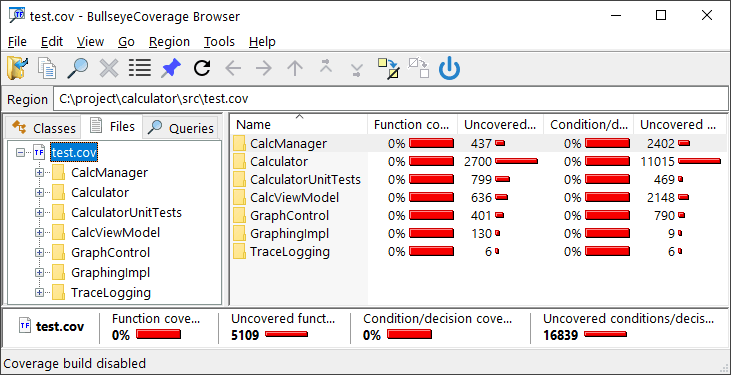BullseyeCoverage
After instrumenting and running your test program, BullseyeCoverage shows information for all project source code but the coverage measurements shown for one or more functions are unexpectedly 0%.

Possible causes of this problem:
LoadLibraryEx was used with the DONT_RESOLVE_DLL_REFERENCES flag,
or an executable module (.exe) was loaded with LoadLibrary or LoadLibraryEx.
BullseyeCoverage,
like shown below.
$ strings calc1.exe | grep "^BullseyeCoverage " BullseyeCoverage 9.18.1 ← software version BullseyeCoverage 9.18.0 ← file format version
On Windows, the strings and grep commands can be found in
Cygwin
or
MSYS2
.
If COVERR is not set,
errors are written to standard error with Windows console programs and Unix-like systems.
With Windows GUI programs, errors are written to %USERPROFILE%\BullseyeCoverageError.txt.
If you find a BullseyeCoverage run-time error occurred, see Run-Time Errors for a description and resolution.
Add a call to cov_write to your program at a point you believe is executed. For embedded systems or test programs that use the small footprint run-time configuration, call cov_dumpData instead. Display the return code status and look it up at Run-Time Errors.
#include <stdio.h> … fprintf(stderr, "cov_write %d\n", cov_write());
#include <stdio.h>
…
{
FILE * f = fopen("logfile", "a");
fprintf(f, "cov_write %d\n", cov_write());
fclose(f);
}
#include <windows.h>
…
{
char buf[99];
wsprintf(buf, "cov_write %d\n", cov_write());
MessageBox(0, buf, 0, 0);
}
printk(KERN_INFO "BullseyeCoverage: cov_check=%d\n", cov_check());
DbgPrintEx(DPFLTR_DEFAULT_ID, DPFLTR_ERROR_LEVEL, "BullseyeCoverage: cov_write=%d", cov_write());
DONT_RESOLVE_DLL_REFERENCES.
Do not load an executable module (.exe) with LoadLibrary or LoadLibraryEx.
The coverage file does not grow in size with new coverage. To determine whether the coverage file has been updated, view a coverage report.
Updated: 14 May 2025
Copyright © Bullseye Testing Technology. All Rights Reserved.